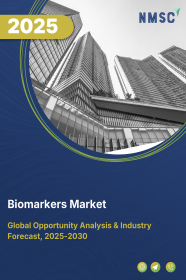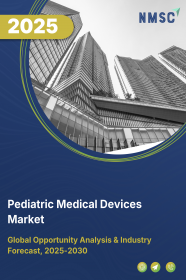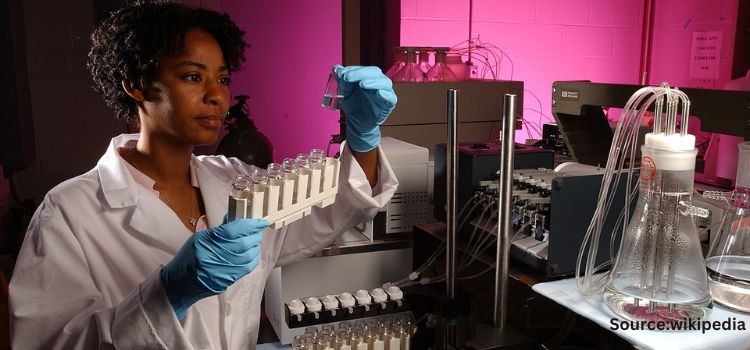
Biomarkers Market by Product & Services (Consumable, Service, and Software), by Type (Safety, Efficacy and Validation), by Technology (Immunoassays, NGS, and Others), by Disease Indication (Cancer, Infectious Diseases, and Other Disease Indication), by Application (Diagnostics, Drug Discovery and Development, Personalized Medicine, and Others) and End Users (Pharmaceutical and Biotechnology Companies and Others) – Global Opportunity Analysis and Industry Forecast 2025 – 2030
US Tariff Impact on Biomarkers Market
Trump Tariffs Are Reshaping Global Business
Biomarkers Market Overview
The global Biomarkers Market size was valued at USD 67.70 billion in 2024 and is predicted to reach USD 133.51 billion by 2030 with a CAGR of 11.9% from 2025-2030.
The increasing prevalence of chronic diseases along with increasing adoption of biomarkers in drug development and clinical trials and advancements in imaging technologies drives the growth of the market. However high cost towards development of biomarker hinders the market growth.
On the contrary, integration of AI driven biomarker diagnostics presents significant opportunities for the future market expansion. Key companies including Roche AG and Thermo Fisher Scientific are investing in various R&D programs to hold their market presence. This continuous development of precision medicine and early disease detection methods is expected for further transformation that enhances the healthcare efficiency.
Rising Prevalence for Chronic Diseases Drives the Market Growth
The escalating global burden of chronic diseases, such as cancer, cardiovascular diseases (CVD), and diabetes, is a primary driver of the biomarkers market growth. Clinical diagnostics serve as critical tools for accurate diagnosis, prognosis, and personalized treatment, addressing the urgent need for effective disease management.
According to the World Health Organization (WHO), non-communicable diseases (NCDs) accounted for 41 million deaths in 2023, with cardiovascular diseases claiming 17.9 million lives, followed by cancer (9.3 million) and diabetes (2 million). The growing incidence of these conditions necessitates advanced diagnostic solutions, propelling the industry size and growth potential.
Growing Advancements in Drug Discovery Propels the Biomarkers Market Expansion
The increasing adoption of biomarkers in drug development and clinical trials is transforming the pharmaceutical industry by streamlining the identification of viable drug candidates and optimizing trial outcomes.
Biomarkers enhance efficiency in target validation, patient stratification, and efficacy assessment, reducing development timelines and costs. A notable example is the June 2024 partnership between Koneksa and Beacon Biosignals, which integrated home electroencephalogram (EEG) technology into Koneksa’s Neuroscience Solution Toolkit for clinical trials targeting sleep and neurologic disorders. This collaboration underscores the rising prominence of digital biomarkers, contributing to the market expansion and reinforcing its role in precision medicine.
Advancements in Imaging Technology Drives the Market Growth
Advancements in imaging technologies, such as nano-imaging and molecular imaging, are revolutionizing biomarker discovery and application, further driving market growth. These technologies enable non-invasive, high-resolution visualization of disease processes, improving early detection and diagnostic accuracy.
In April 2023, Nanovery, in collaboration with National Health Service (NHS) scientists, developed a nanorobot-based technology for detecting biomarkers directly in blood serum samples. This breakthrough enhances the early diagnosis of life-threatening diseases, such as cancer, and supports better patient outcomes, solidifying imaging technology’s role in expanding the industry revenue.
High Cost Associated with the Development of Biomarkers Hinders the Market
Despite the promising growth trajectory, the high cost associated with biomarker development remains a significant barrier. The complex processes of discovery, validation, and regulatory approval require substantial financial investment, posing challenges for smaller companies and research institutions. These costs limit innovation and slow the introduction of new biomarkers, hindering overall market growth. Addressing this restraint will be critical to unlocking the full potential of the biomarkers market trends.
Incorporation of AI into Research and Development Creates Future Opportunity for the Market Growth
The incorporation of artificial intelligence into companion diagnostics research and diagnostics represents a transformative opportunity for the biomarkers market demand. AI enhances precision in drug discovery, reduces research timelines, and improves diagnostic accuracy through advanced data analysis and predictive analytics.
A groundbreaking example is the 2024 development by researchers at the National Institutes of Health (NIH) and Memorial Sloan Kettering Cancer Center, who created an AI-based tool to predict cancer patients’ responses to immunotherapy using routine clinical data. This innovation, reported in 2024, demonstrates AI’s potential to revolutionize biomarker discovery and personalized treatment, driving significant market growth in the coming years.
In August 2024, Illumina Inc. received U.S. Food and Drug Administration (FDA) approval for its TruSight Oncology (TSO) Comprehensive test, a next-generation sequencing (NGS)-based assay that profiles over 500 genes to identify actionable biomarkers for cancer therapies. This launch enhances precision oncology by enabling faster patient matching to targeted treatments, underscoring the role of innovative diagnostics in expanding the biomarkers market share.
Market Segmentation and Scope of Study
The biomarkers market report is segmented on the basis of product & services, type, technology, disease indication, application, end user, and region. On the basis of product and services, the market is consumables, services, and software. On the basis of type, the market is classified into safety, efficacy, and validation. Efficacy is further divided into predictive, surrogate, pharmacodynamic, and prognostic types. On the basis of technology, the market is divided into immunoassays, next-generation sequencing (NGS), polymerase chain reaction (PCR), mass spectrometry, and chromatography. Further, immunoassays is further divided into ELISA, protein microarrays, and Western blot. On the basis of disease indication, the market is segmented into cancer, infectious diseases, immunological diseases, neurological diseases, cardiovascular diseases, and other disease indications. On the basis of application, the market is bifurcated into diagnostics, drug discovery and development, personalized medicine, and others. On the basis of end users, the market is segmented into hospitals and diagnostics laboratories, and academic and research institute. Regional breakdown and analysis of each of the aforesaid segments includes regions comprising of North America, Europe, Asia-Pacific, and Rest of World (RoW).
Geographical Analysis
North America dominates the biomarkers market share currently and is expected to continue its dominance throughout the forecast period. This trend can be attributed to the increasing adoption of biomarkers aimed at reducing the risks associated with laboratory-developed tests within the country.
Notably, the U.S. Food and Drug Administration (FDA) has launched a pilot program designed to mitigate the risks linked to laboratory-developed tests used for identifying cancer biomarkers. This initiative seeks to provide transparent performance recommendations for diagnostic tests that are utilized to select specific oncology drug treatments.
In addition, growing diagnosis of Alzheimer's disease and other neurological disorders at earlier stages is propelling the market growth. Recently Labcorp developed a new blood test that measures three biomarkers to identify and assess Alzheimer's disease related biological changes. It can also be used to detect and confirm other neurological disorders such as Amyotrophic lateral Sclerosis and concussion.
The ATN Profile is available nationwide for patients who are being evaluated for possible Alzheimer's disease or other causes of cognitive impairment. As the demand for early and accurate diagnosis continues to rise, innovations like play a crucial role in advancing the biomarker market and improving patient outcomes.
On the other hand, the Asia-Pacific region is recognized as the fastest-growing area in the biomarker industry, primarily due to the increasing utilization of AI-based technology for identifying cancer drugs, which is significantly driving market growth. In March 2023, Fujitsu, in collaboration with Kyoto University and Chordia Therapeutics, launched AI trials aimed at discovering biomarkers for new cancer therapies.
This initiative employs AI causal discovery technology to identify biomarkers that can help predict the success or speed of clinical trials for new cancer drugs. As the integration of advanced technologies continues to evolve, the Asia-Pacific region is poised to become a key player in the global biomarker landscape, fostering innovation and enhancing the development of targeted cancer treatments.
Furthermore, leading companies in the biomarker industry are increasingly adopting a variety of business strategies, including partnerships and expansions, which are significantly contributing to market growth. For instance, in June 2023, Aignostics and Virchow Laboratories formed a partnership to develop and promote AI-powered pathology in China for both research and clinical applications. This collaboration aims to enhance and expedite disease diagnosis, addressing the critical shortage of pathologists in the region. Their innovative detection and classification approach allows for a deeper exploration of morphology, ultimately improving diagnostic accuracy and efficiency. As these strategic alliances continue to emerge, they continue to drive advancements in biomarker technologies and expand access to essential diagnostic services.
Strategies Adopted by the Key Companies
Key players in the global biomarkers industry are actively pursuing strategies to enhance the precision, accessibility, and scope of diagnostic tools to capture a larger market share and capitalize on the significant growth potential in this sector. Recent developments include advancements in high-sensitivity biomarker assays, the integration of artificial intelligence (AI)-driven diagnostics, and the expansion of multi-biomarker panels, which are increasingly complementing traditional methods to improve early detection and personalized treatment outcomes.
There is also a growing trend toward developing comprehensive biomarker panels capable of simultaneously detecting multiple disease indicators, such as those for cancer, Alzheimer’s disease, cardiovascular conditions, and kidney disorders, although challenges remain in ensuring scalability, cost-effectiveness, and standardization compared to single-biomarker assays.
For instance, in March 2023, F. Hoffmann-La Roche Ltd. collaborated with Eli Lilly and Company to develop a blood-based biomarker test to enhance early diagnosis of Alzheimer’s disease. This initiative aims to improve patient outcomes by streamlining the journey to timely and accurate diagnosis and treatment, highlighting the industry’s shift toward innovative, patient-centric diagnostic solutions.
More recently, in July 2024, Biogen Inc., Beckman Coulter, Inc., and Fujirebio entered a collaboration to identify and develop blood-based biomarkers for tau pathology in Alzheimer’s disease, with the goal of advancing and potentially commercializing new diagnostic tests. This partnership underscores the focus on non-invasive products to improve neurological diagnostics.
Additionally, in August 2024, Illumina Inc. received U.S. Food and Drug Administration (FDA) approval for its TruSight Oncology (TSO) Comprehensive test, a next-generation sequencing (NGS)-based assay profiling over 500 genes to identify actionable cancer biomarkers, further driving precision oncology by enabling faster patient matching to targeted therapies.
Another significant development occurred in October 2024, when Genialis launched Genialis krasID, the first RNA-based biomarker designed to predict tumor response and clinical benefits of KRAS inhibitors in cancer patients. This innovation highlights the growing role of RNA biomarkers in precision medicine. Furthermore, in February 2025, Grifols partnered with IBL International to develop advanced biomarker panels for a unique clinical diagnostics platform, focusing on oncology and neurology applications using multiplex assays and single-molecule counting technologies. This collaboration aims to address unmet diagnostic needs by improving test sensitivity and specificity.
A key challenge for industry players lies in addressing the high costs associated with biomarker development and validation, as well as the need for standardized protocols to ensure reproducibility across diverse populations. The complexity of integrating multi-omics data and ensuring regulatory compliance also poses hurdles.
However, significant opportunities exist in refining multi-omics approaches, such as integrating genomics, proteomics, and metabolomics, to enhance the specificity and predictive power of biomarker panels. The advent of liquid biopsy tests, exemplified by PreAnalytiX’s September 2024 launch of the PAXgene Urine Liquid Biopsy Set, offers non-invasive alternatives for detecting biomarkers, further expanding market potential.
Moreover, the exploration and validation of non-invasive sample types, such as blood, saliva, and urine, for detecting biomarkers of neurological, oncological, and renal diseases are opening new avenues for market expansion. Studies demonstrating the efficacy of blood-based products for Alzheimer’s disease, as seen in Roche’s collaboration with Lilly and Biogen’s tau pathology project, underscore the potential to improve diagnostic accuracy across age groups and disease stages.
Similarly, the use of urine-based biomarkers, as advanced by PreAnalytiX, enhances accessibility and patient comfort. Future research is focusing on leveraging AI to optimize data analysis for biomarker discovery, developing cost-effective testing platforms suitable for widespread screening, and adapting diagnostic protocols based on real-world epidemiological data. These efforts, combined with strategic collaborations like Quibim’s January 2024 partnership with Merck KGaA to advance precision medicine for cancer, are expected to shape market trends, drive the industry size, and position it as a cornerstone of precision medicine.
Key Benefits
-
The report provides quantitative analysis and estimations of the industry from 2025 to 2030, which assists in identifying the prevailing biomarkers market opportunities.
-
The study comprises a deep-dive analysis of the current and future market trends to depict prevalent investment pockets in the biomarkers sector.
-
Information related to key drivers, restraints, and opportunities and their impact on the market is provided in the report.
-
Competitive analysis of the players, along with their market share is provided in the report.
-
SWOT analysis and Porters Five Forces model is elaborated in the study.
-
Value chain analysis in the market study provides a clear picture of roles of stakeholders.
Biomarkers Market Key Segments
By Product & Services
-
Consumable
-
Service
-
Software
By Type
-
Safety
-
Efficacy
-
Predictive
-
Surrogate
-
Pharmacodynamic
-
Prognostic
-
-
Validation
By Technology
-
Immunoassays
-
Elisa
-
Protein Microarrays
-
Western Blot
-
-
NGS
-
PCR
-
MASS Spectrometry
-
Chromatography
By Disease Indication
-
Cancer
-
Infectious Diseases
-
Immunological Diseases
-
Neurological Diseases
-
Cardiovascular Diseases
-
Other Disease Indication
By Application
-
Diagnostics
-
Drug Discovery and Development
-
Personalized Medicine
-
Others
By End User
-
Pharmaceutical and Biotechnology Companies
-
Hospitals and Diagnostics Laboratories
-
Academic and Research Institutes
By Region
-
North America
-
The U.S.
-
Canada
-
Mexico
-
-
Europe
-
The UK
-
Germany
-
France
-
Italy
-
Spain
-
Denmark
-
Netherlands
-
Finland
-
Sweden
-
Norway
-
Russia
-
Rest of Europe
-
-
Asia-Pacific
-
China
-
Japan
-
India
-
South Korea
-
Australia
-
Indonesia
-
Singapore
-
Taiwan
-
Thailand
-
Rest of Asia-Pacific
-
-
Rest of the World
-
Latin America
-
Middle East
-
Africa
-
Key Players
-
F. Hoffmann-La Roche Ltd.
-
Abbott Laboratories
-
Epigenomics AG
-
General Electric
-
Johnson & Johnson Services, Inc.
-
Thermo Fisher Scientific Inc.
-
Siemens Healthcare GmBH
-
Merck & Co., Inc.
-
Enzo Biochem Inc.
-
Bio-Rad Laboratories, Inc.
-
Qiagen
-
Agilent Technologies Inc.
-
Charles River Laboratories
-
Revvity Inc.
-
Eurofins Scientific
REPORT SCOPE AND SEGMENTATION:
|
Parameters |
Details |
|
Market Size in 2024 |
USD 67.70 Billion |
|
Revenue Forecast in 2030 |
USD 133.51 Billion |
|
Growth Rate |
CAGR of 11.9% from 2025 to 2030 |
|
Analysis Period |
2024–2030 |
|
Base Year Considered |
2024 |
|
Forecast Period |
2025–2030 |
|
Market Size Estimation |
Billion (USD) |
|
Growth Factors |
|
|
Countries Covered |
28 |
|
Companies Profiled |
15 |
|
Market Share |
Available for 10 companies |
|
Customization Scope |
Free customization (equivalent to up to 80 working hours of analysts) after purchase. Addition or alteration to country, regional, and segment scope. |
|
Pricing and Purchase Options |
Avail customized purchase options to meet your exact research needs. |

















 Speak to Our Analyst
Speak to Our Analyst




















